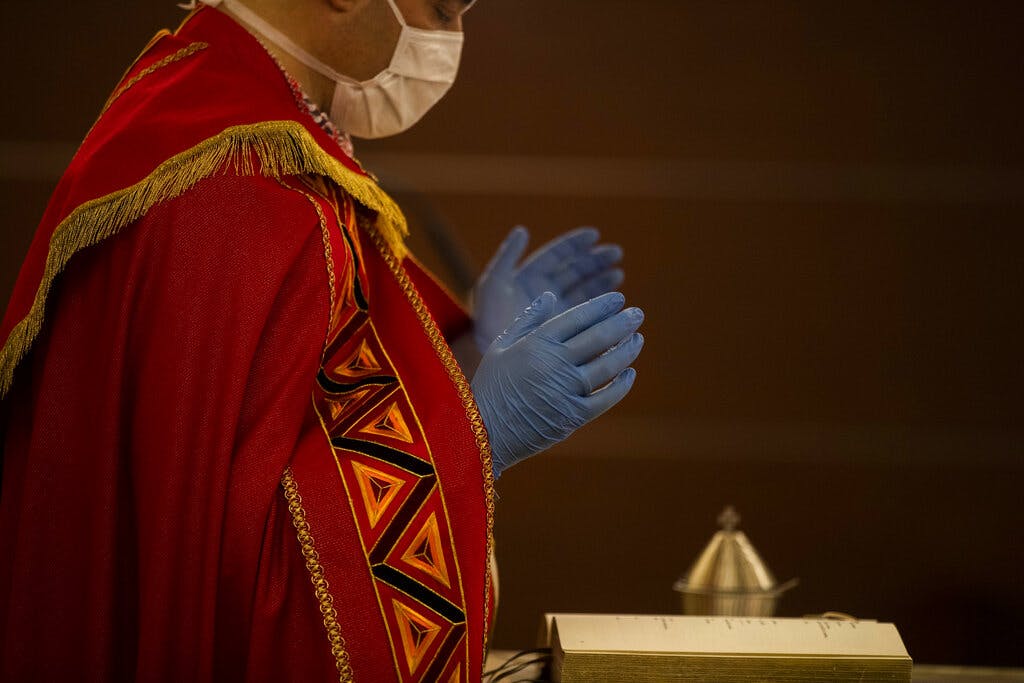By Frank C. Senn
For years I wrote an opinion column for Let’s Talk at the invitation of the editorial board called “As I See It.” Even though Let’s Talk has adopted a blog format rather than an issue number format, I feel the need for another one as our states begin opening up society again, including churches.
Lutheranism has a long tradition – actually since our beginning in the 1520s – of promoting public health. Martin Luther promoted the common chest in Wittenberg to remove beggars from the streets and provide for the hungry poor. Monasteries were turned into hospitals and schools supported by the endowments monasteries had accumulated over the centuries. The Reformed Churches followed in the same direction. The Hospital in Calvin’s Geneva was a full service institution. So were the orphanages, hospital, and German school (with its teaching of science) founded in Halle by Lutheran pietist leader August Hermann Francke. Halle also sponsored the first foreign mission venture in cooperation with the Church of Denmark (in India) and medical missions almost immediately accompanied evangelistic missions.
Because of the untimely deaths of missionaries, the physical culture movement in Prussia (Friedrich Jahn, who studied theology at Halle and is the father of modern physical education) and Sweden (Pehr-Henrik Ling, who studied theology at Lund and Uppsala and founded the Swedish Gymnastic Academy) developed body work and movement techniques to provide bodies fit for service in foreign lands. The same concern for healthy bodies and healthy societies was applied to inner mission work in 19th century German industrial cities. The founding of deaconess communities in Germany in the 19th century (e.g. in Kaiserwerth by Theodor Fledner; in Neuendettelsau by Wilhelm Loehe) was primarily to provide nurses for hospitals. (Florence Nightingale studied nursing in the deaconess hospital in Kaiserwerth.) Pastor William Passavant brought German deaconesses to the U.S. and devoted a career to founding hospitals in the U.S. (including in Chicago). Our Lutheran social service institutions and hospitals have made a valuable contribution to promoting a healthy society.
I like to think that in Lutheran spirituality there’s a connection between our belief in the real presence of the body and blood of Christ in the Eucharist and the attention given to healthy human bodies in society. The early Lutherans used to contribute to the common chest when they came forward to receive Holy Communion. The body is an important, if understudied, category in Lutheran spirituality.
In the light of this history, Lutherans should be in the forefront of promoting the best public health recommendations during this COVID-19 pandemic by supporting the governing authorities in their efforts to mitigate infections and prevent deaths. The main recommendation is maintaining social distancing out of respect for the bodies of others as well as our own. As our society begins opening up again, state by state, the need for social distancing must be respected. This coronavirus is going to be with us for a long time and, as Dr. Anthony Fouci has emphasized, lacking a vaccine the only protection we have of mitigating this pandemic is maintaining social distancing, washing hands frequently, and wearing face coverings. These standards must also be applied to the opening up of church buildings for public worship, once the state or local authorities indicate that this can be done and under what conditions.
There may be restrictions at first on how large a group can assemble. Perhaps at first ten, then fifty. Will your congregation open its building for public worship with these restrictions? How do you decide which ten or fifty members can get in? By having the members make reservations? By increasing the number of services to accommodate more worshipers? Would this be a typical kind of response? “Reservations are available at 8 a.m. but not at 10 a.m.? There are plenty of openings at Noon. Would you like to reserve a pew at that service?” Would you turn away worshipers who show up without a reservation but would be too many for the state’s requirements? Would you offer just one service and live stream it?
Even if numerical restrictions are lifted, each worship space is unique and each congregation will have to figure out the logistics of keeping worshipers six feet apart (except for family units). This will probably involve leaving every other pew or seating row empty and forcing some people to sit even in the front. Worship spaces that use movable seats can remove some seats and space out what remains (an advantage to cathedral seating). The church should count the estimated seating capacity and alert the congregation as to how many can be accommodated with this arrangement. Again I say, it may be necessary to offer multiple services.
The return of choirs will require special consideration and advice. Can the choir sing with masks on? Does space allow choir and musicians to be spread out? This might produce an interesting new sound!
Face masks should be recommended and provided to worshipers who lack one as they enter. People may also want to wear latex gloves, although custodians should be instructed to constantly sanitize door knobs and railing. Hand sanitizers should be everywhere.
For greetings, including the greeting of peace, I wouldn’t even recommend elbow bumping. A nod of the head or even a reverent bow of the body would be appropriate. Offering plates should not be passed. People can deposit offerings before or after the service. Processing to communion stations to receive the sacrament will require the same 6-feet of distancing that is practiced in stores. Communion practices will require special attention, as will baptisms. The sacraments are meant for and are applied to bodies. There’s no way to get around that. I will address here only Holy Communion.
People have missed receiving Holy Communion while churches were shut or in-person worship was prohibited. So-called virtual communion and spiritual communion, offered by some churches, were inadequate substitutes for the celebration of the Eucharist in the Eucharistic assembly. In terms of handling the eucharistic elements, the distribution of the bread provides fewer issues than the distribution of the wine. The ministers should wear latex gloves from the time they begin handling the elements for the distribution. Loaves of bread can be broken and pieces placed in the hands of communicants. But whether broken pieces or wafers are offered, the bread is placed into the cupped hands of the communicants without touching hands. It can be done with a slight drop. If hands touch, change gloves.
The wine presents real difficulties. Drinking from the cup (hands holding the base, wiping the lip), intincting bread into the wine (fingers in the wine), or even the use of individual glasses (fingers touching the glasses, washing them adequately) all present problems of administration. Of the options, I would still prefer drinking from the communion cup properly handled, although that seems counterintuitive to many people. However, in spite of the Protestant reformers’ contention for the restoration of the cup to lay communicants, a lot of problems might be solved (at least initially when there are so many other issues to be managed in returning to public worship) by offering communion in the bread only. The doctrine of concomitance holds that the entire Christ is received under either species. But the cup of wine must be on the altar for the complete sacramental symbol and the celebrant or presiding minister will consume the blood of Christ on behalf of everyone.
Some church members, especially the vulnerable such as the elderly or those with health conditions, should be advised to stay at home and not attend public worship. Justin Martyr, in his Apology 67 reported that after the Sunday Eucharist the consecrated elements are sent to the absent by the deacons. Did the deacons stay for a visit and administer the communion elements? Did they hand over the elements and leave them for self-communion? We don’t know.
The extended distribution of communion can be offered to our home bound/stay-at-home members. This practice is a way of connecting the absent with the congregation’s Eucharist. Let’s say that a half dozen communion minister visit up to a half dozen households with bread from the Eucharist in a suitable container such as ciboria or pyx. They let the household know in advance of their arrival. A member of the household meets the communion minister at the door and receives sufficient hosts for communion in that household and a card with devotions for communing the household. Then the communion ministers extends the greeting of peace with a bow and departs. Social distancing requires that conversation is not prolonged, especially if the minister is visiting the vulnerable. As in the old Lutheran practice of announcing one’s intention to receive Communion to the pastor ahead of the service, those who wish to receive Communion by extended distribution should inform the church office. The pastor or a deacon can still take the sacrament to the hospitalized, observing the hospital protocols.
Self-communion at home with bread consecrated at the church’s Eucharist was a practice of the ancient church for communion at the end of fasting periods and during times of persecution. The church order known as The Apostolic Tradition indicated that the faithful self-communing at home could dip the consecrated bread into a glass of wine, thus consecrating the wine by contagion, as it were. (We may not want to teach that, but it’s what the ancient Roman Church practiced in Ordo Romanus Primus.) Communion devotions could include the Lord’s Prayer, a prayer for communion, and a post-communion thanksgiving taken from our worship book. There is a lot of precedent to draw on from the liturgical tradition. The church didn’t always do things we way we used to doing. But changes require careful instruction.
Working out the logistics of trying to maintain public health standards while trying to be faithful to our liturgical-theological traditions, will require creativity. I suspect there will be trial-and-error as congregations figure out how to manage this unprecedented situation. What I have suggested here is a way of proceeding, as I see it.


